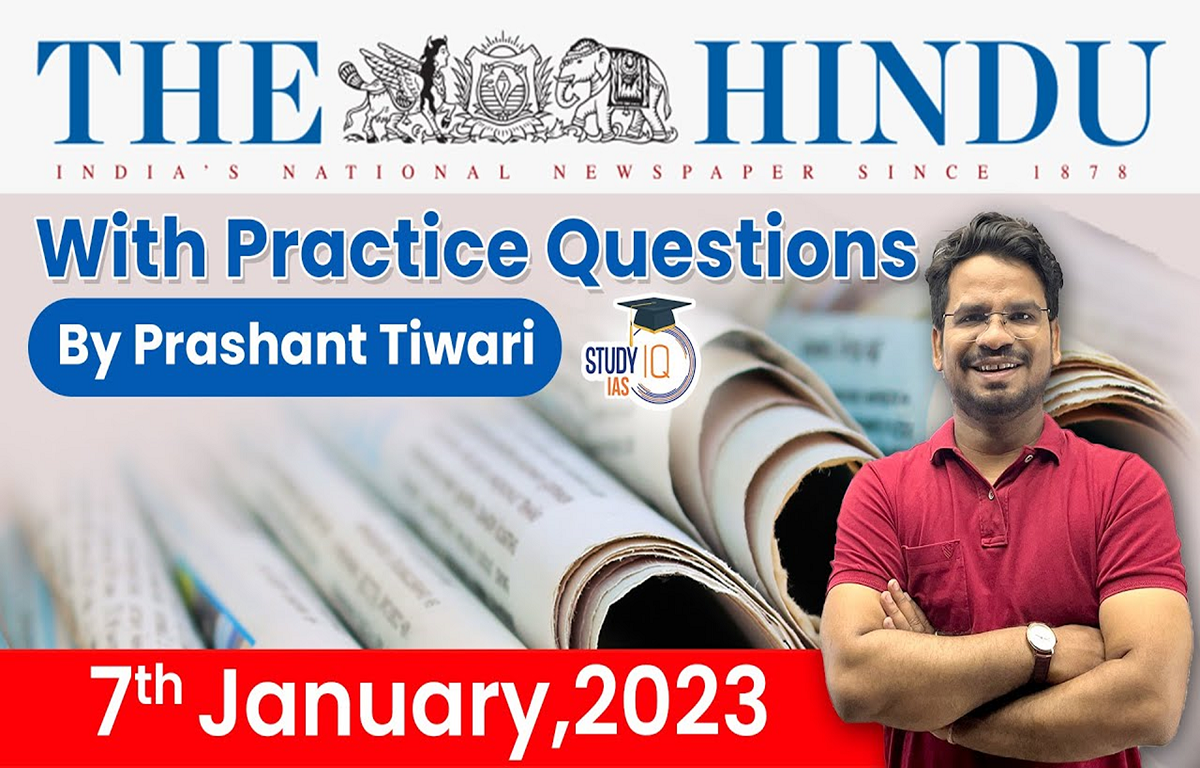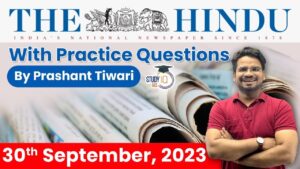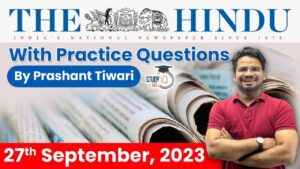The Hindu Newspaper Analysis for UPSC
- The Supreme Court on Friday transferred to itself petitions pending in various High Courts seeking legal recognition of same-sex marriage.
- A three-judge Bench led by Chief Justice of India D.Y. Chandrachud said there was broad consensus among the petitioners to shift the cases to the Supreme Court for an authoritative ruling on the issue, especially on the question whether same-sex marriage should be brought within the ambit of the Special Marriage Act of 1954.
- Batches of petitions were pending before the Delhi, Kerala and Gujarat High Courts. The Bench, also comprising Justices P.S. Narasimha and J.B. Pardiwala, directed the Centre to file its response to the petitions on or before February 15.

- As another round of refugee crisis brews on the Mizoram-Bangladesh border, several members of the Kuki-Chin community were “pushed back” by the Border Security Force (BSF) on Friday, according to K. Vanlalvena, a Rajya Sabha member from Mizoram.
- They entered Mizoram illegally as a result of fighting between the army of the neighboring country and an ethnic armed group.
- The Bangladesh Rapid Action Battalion has started an operation against a few of the group’s insurgents.
- Mizoram, which already has 30,000 refugees from Myanmar after a coup, is now dealing with a new influx from Bangladesh, with whom it shares a 318-km-long international border that is partially fenced.
Who are the Kukis?
- The Kukis are an ethnic group including multiple tribes originally inhabiting the North-Eastern states of India such as Manipur, Mizoram and Assam; parts of Burma (now Myanmar), and Sylhet district and Chittagong hill tracts of Bangladesh.
- While Kuki is not a term coined by the ethnic group itself, the tribes associated with it came to be generically called Kuki under colonial rule.
- They exist in every state in Northeast India, with the exception of Arunachal Pradesh.
- A total of fifty Kuki tribes in India are recognized as scheduled tribes based on the dialect and geographic origin of that particular Kuki community.
- The Kukis are related to the Chin people of Myanmar and the Mizo people of Mizoram.
India’s stand on refugees
- India is not a signatory to the 1951 UN Convention relating to the Status of Refugees and the 1967 Protocol.
- All foreign undocumented nationals are governed as per the provisions of The Foreigners Act, of 1946, The Registration of Foreigners Act, of 1939, The Passport (Entry into India) Act, of 19,20, and The Citizenship Act, of 1955.

- Just when the world was recovering from the pain induced by COVID-19, Russia’s invasion of Ukraine last year once again highlighted the ‘crisis’ dimension of international law.
- One of the underlying bases of the post-world war international legal order has been to explicitly outlaw war through the adoption of the United Nations (UN) Charter. While the UN Charter has succeeded in ensuring that the world does not fight another world war, it has failed in stopping inter-state wars.
- The world post-World War II was a bipolar one with great power competition between a ‘capitalist’ America and a ‘communist’ Soviet Union.
- However, even during this period, the North Atlantic Treaty Organization bombed Kosovo and the Western forces invaded Iraq in complete disregard to the UN Charter.

- The analogy is made to press home the point that just as CEOs are held accountable for a bad quarter, so should the leaders of political parties for poor election results. This analogy is misleading and leads to distorted ideas of how political parties function.
- A key difference between a political party and a company is that parties have claimants and volunteers while a company has employees.
- The purpose of a political party is to capture state power in service of some stated social agenda. To legitimise this aspiration, the party itself must be seen to be as a microcosm of society, with its organisation necessarily populated by individuals in a volunteer capacity as opposed to paid employees.
- Ultimately, politics is a value-driven enterprise. We should seek competence and accountability from political functionaries, but the way forward is not through the corporatisation of our parties.

- Six civilians, including two children, were killed in brutal acts of terrorism in Dangri in Jammu and Kashmir’s Rajouri in the first week of the new year.
- There is fresh demand to revive Village Defence Committees, which were constituted in 1995 in 10 districts of the Jammu region to fight militants in remote places where security presence is thin.
- While new experiments may yield different results in J&K, the old approach to allow multiple processes of engagement to address issues in a democratic way might still work. In the absence of an elected government in J&K since 2018, even the mainstream of the region is drifting away from New Delhi.
- A continuing political process is not a sufficient guarantee against Pakistan-backed terrorism, but it is a necessary condition in any resolution of the Kashmir conflict.

- India is set to deploy an all-woman platoon of peacekeepers as part of a battalion to the United Nations Interim Security Force in Abyei (on the border between South Sudan and Sudan), which will be India’s largest single unit of women peacekeepers in a UN mission since the deployment of the first-ever all woman contingent in Liberia in 2007, according to India’s Permanent Mission to the United Nations in New York.
- India is one of the largest troop-contributing nations to the UN peacekeeping missions. “India has a tradition of active participation in U.N. peacekeeping missions. The participation by our Nari Shakti is even more gladdening,” Prime Minister Narendra Modi said on Twitter.

- When the UN Security Council approved the deployment of UN military observers to the Middle East in 1948, the UN Peacekeeping Forces were established.
- UN peacekeeping forces aid nations in negotiating the perilous transition from war to peace.
- To carry out several missions approved by the UN Security Council (UNSC) and the UN General Assembly, it deploys soldiers and police from all over the world and combines them with civilian peacekeepers.
- International Day of UN Peacekeepers is celebrated on date 29th May every year.
- India is among the nations that send the most troops to the United Nations Peacekeeping Forces.
- Example: India is the second-highest military and fifth-highest police contributing country to the United Nations Organization Stabilization Mission in the Democratic Republic of the Congo (MONUSCO).
- Over 2,60,000 Indians have served in 49 U.N. Peacekeeping missions since 1948.
- In 2007, India became the first country to deploy an all-women contingent to a UN Peacekeeping mission.
- In the last six decades, 179 Indian soldiers have died in UN Peacekeeping operations.
- Among “blue helmets” it has the greatest death toll of any nation.
- Blue Helmets are the military personnel of the UN that work alongside the UN Police and civilian colleagues to promote “stability, security, and peace processes”.

- The Supreme Court on Friday directed its committee led by a former apex court judge, Justice A.M. Sapre, to meet with the Road Transport Secretary within two weeks and work out a framework to mould State-specific guidelines for the electronic monitoring and enforcement of road safety. The court acknowledged that speeding was the main cause of fatal accidents on Indian roads.
- A Bench led by Chief Justice D.Y. Chandrachud agreed that urgent steps need to be taken to enforce Section 136A (electronic monitoring and enforcement of road safety) of the Motor Vehicles Act, 1988. The provision was introduced into the Act in 2019 to keep an electronic eye on errant drivers.
Brasilia Declaration on Road Safety (2015):
- The declaration was signed at the second Global High-Level Conference on Road Safety held in Brazil. India is a signatory to the Declaration.
- The countries plan to achieve Sustainable Development Goal 3.6 i.e. to halve the number of global deaths and injuries from road traffic accidents by 2030.
Decade of Action for Road Safety 2021-2030:
- The UN General Assembly adopted resolution “Improving global road safety ” with the ambitious target of preventing at least 50% of road traffic deaths and injuries by 2030.
- The Global Plan aligns with the Stockholm Declaration, by emphasizing the importance of a holistic approach to road safety.
The International Road Assessment Programme (iRAP) :
- It is a registered charity dedicated to saving lives through safer roads.

- Short-time work and work-sharing measures or other forms of job retention helped people reduce the volume of work and save jobs during the COVID-19 pandemic, said a report of the International Labour Organisation (ILO) released on Friday.
- The report, titled ‘Working Time and Work-Life Balance Around the World’, said flexible working hours enabled individuals as well as companies, enterprises and industries to collectively reduce the hours of work, a trend already generated before the crisis.
- The crisis also created the possibility of increasing the hours of work for new economic bottleneck areas, such as in the healthcare or pharmaceutical industries.
- The system of reduced working hours and flexible working time arrangements can benefit economies, enterprises and workers, and lay the ground for a better and more healthy work-life balance, the report noted.
- The report looked at the two main aspects of working time; working hours and working time arrangements (also called work schedules) and the effects of both on business performance and workers’ work-life balance.
Q) The fundamental right of “Freedom of speech and expression” has been interpreted by the law courts to include which of the following rights?
- Right to know about government activities.
- Freedom of silence.
- Right to strike
- Right against imposition of pre-censorship on a newspaper.
Select the correct answer using the code below:
- 1 and 2 only
- 1, 2 and 4 only
- 3 and 4 only
- 1, 2, 3 and 4
“भाषण और अभिव्यक्ति की स्वतंत्रता” के मौलिक अधिकार की व्याख्या कानून अदालतों द्वारा निम्नलिखित में से किस अधिकार को शामिल करने के लिए की गई है?
- सरकारी गतिविधियों के बारे में जानने का अधिकार।
- मौन की स्वतंत्रता।
- हड़ताल का अधिकार
- अखबार पर प्री-सेंसरशिप लगाने के खिलाफ अधिकार।
नीचे दिए गए कूट का प्रयोग कर सही उत्तर चुनिए:
- केवल 1 और 2
- केवल 1, 2 और 4
- केवल 3 और 4
- 1, 2, 3 और 4
Explanation:
- The freedom of speech and expression, in this context, includes:
- Right to propagate one’s views as well as views of others.
- Freedom of the press.
- Freedom of commercial advertisements.
- Right against tapping of telephonic conversation.
- Right to telecast, that is, government has no monopoly on electronic media.
- Right against bundh called by a political party or organisation.
- Right to know about government activities.
- Freedom of silence.
- Right against imposition of pre-censorship on a newspaper.
- Right to demonstration or picketing but not right to strike.
Q) With reference to Article 19 of Constitution of India, consider the following statements.
- The right to freedom of movement grants every citizen the unrestricted right to travel anywhere on the country’s territory.
- All citizens are given the right to practice any profession or to carry on any occupation, trade or business
Which of the above statements is/are correct?
- 1 only
- 2 only
- Both 1 and 2
- Neither 1 nor 2
भारत के संविधान के अनुच्छेद 19 के संदर्भ में, निम्नलिखित कथनों पर विचार करें।
- आने-जाने की स्वतंत्रता का अधिकार प्रत्येक नागरिक को देश के क्षेत्र में कहीं भी यात्रा करने का अप्रतिबंधित अधिकार प्रदान करता है।
- सभी नागरिकों को कोई भी पेशा अपनाने या कोई पेशा, व्यापार या व्यापार करने का अधिकार दिया गया है
उपरोक्त कथनों में से कौन-सा/से सही है/हैं?
- केवल 1
- केवल 2
- 1 और 2 दोनों
- न तो 1 और न ही 2
Explanation:
- Right to freedom of movement entitles every citizen to move freely throughout the territory of the country. The grounds of imposing reasonable restrictions on this freedom are two, namely, the interests of the general public and the protection of interests of any scheduled tribe. The entry of outsiders in tribal areas is restricted to protect the distinctive culture, language, customs and manners of scheduled tribes and to safeguard their traditional vocation and properties against exploitation.
- All citizens are given the right to practise any profession or to carry on any occupation, trade or business. This right is very wide as it covers all the means of earning one’s livelihood.
Q) Gaza strip, often seen in the news, shares a border with which of the following countries?
- Syria
- Egypt
- Jordan
- Israel
Select the correct answer code:
- 1, 2 and 3 only
- 2 and 4 only
- 2, 3 and 4 only
- 1 and 4 only
समाचार में अक्सर देखी जाने वाली गाजा पट्टी निम्नलिखित में से किस देश के साथ सीमा साझा करती है?
- सीरिया
- मिस्र
- जॉर्डन
- इज़राइल
सही उत्तर कूट का चयन करें:
- केवल 1, 2 और 3
- केवल 2 और 4
- केवल 2, 3 और 4
- केवल 1 और 4
Explanation:
- The Gaza Strip is a self-governing Palestinian territory on the eastern coast of the Mediterranean Sea. It borders Egypt on the southwest and Israel on the east and north.

Q) Which of the following pairs is/are correctly matched?
- Parasnath hill: Jharkhand
- Shetrunjay hill: Bihar
- Nandi hills: Karnataka
Select the correct answer using the code below:
- 1 and 2 only
- 2 and 3 only
- 1 and 3 only
- 1, 2 and 3
निम्नलिखित युग्मों में से कौन-सा/से सही सुमेलित है/हैं?
- पारसनाथ पहाड़ी : झारखंड
- शत्रुंजय पर्वत : बिहार
- नंदी पहाड़ियाँ : कर्नाटक
नीचे दिए गए कूट का प्रयोग कर सही उत्तर चुनिए:
- केवल 1 और 2
- केवल 2 और 3
- केवल 1 और 3
- 1, 2 और 3
Explanation:
- Members of the Jain community have been staging protests across the country for the past two weeks over demands related to two holy sites — Sammed Shikhar on Parasnath hill in Jharkhand and Shetrunjay hill in Palitana of Gujarat.
- Nandi hills: Karnataka
Q) Utkarsh 2.0 is a
- LIC’s revamped mutual fund scheme
- RBI’s Medium-term strategy framework
- SEBI’s new trading policy
- ISRO’s restructured innovation framework
उत्कर्ष 2.0 एक है
- एलआईसी की संशोधित म्यूचुअल फंड योजना
- आरबीआई की मध्यम अवधि की रणनीति ढांचा
- सेबी की नई व्यापार नीति
- इसरो का पुनर्गठित नवाचार ढांचा
Explanation:
- RBI ‘s Medium-term strategy framework- Utkarsh 2.0 (for 2023-2025) was launched recently.
- Utkarsh 1.0 was for the period 2019-2022
- Utkarsh 2022 is a medium-term strategy in line with the global central banks’ plan to strengthen the regulatory and supervisory mechanism
Mains Practice Question:
Q) “After decades of the 73rd and 74th constitutional amendments, local governments still remain constrained and inefficient.” Discuss. (150 words)
“73वें और 74वें संवैधानिक संशोधनों के दशकों के बाद, स्थानीय सरकारें अभी भी विवश और अक्षम हैं।” विचार-विमर्श करना। (150 शब्द)
Introduction:
- Decentralized democratic governance was introduced in India by the 73rd and 74th Constitution Amendments 30 years ago. Local government posed to be a vehicle of inclusive growth and development and tool of empowering democracy. Unfortunately after 30 years local government is inefficient and corrupt. Indeed, the village panchayats have not succeeded in enhancing the well-being, capabilities and freedom of citizens.
Body
Issues and Inefficiencies in Local government in India:
- Inadequate devolution: Devolution, envisioned by the Constitution, is not mere delegation. It implies that precisely defined governance functions are formally assigned by law to local governments, backed by adequate transfer of financial grants. All states have not been forthcoming in giving Panchayats and Municipalities enough funds, functions and functionaries.
- Low technical knowledge: Low technical knowledge has restricted the aggregation of planning from village to block to district to state to centre. Hence bottom up approach of planning is very limited.
- Adhoc meetings: There is lack of clear setting of agenda in gram sabha meetings leading to adhocism with no proper structure.
- States’ attitude: From postponing the elections to the failure to constitute State Finance Commissions and District Planning Committees (DPCs), States have been seen to violate the various provisions of Parts IX and IXA.
- Inadequate Infrastructure: Insufficient staffing, office space, and infrastructure bottlenecks hamper the functioning of local bodies.
- Less taxes: Panchayats and Municipalities have not used their financial powers efficiently. Very few Gram Panchayats levy and collect taxes (on markets, fairs, property, business and so on).
- Parallel Institutions: Most States continue to create parallel bodies that make inroads into the functional domain of local governments.
- Criminal politics: Criminal elements and contractors are attracted to local government elections, tempted by the large sums of money now flowing to them. They win elections through bribing voters and striking deals with different groups.
Conclusion
- A reasonably robust democratic structure for local governance should be given life through the practice of a robust democratic culture. It is important to instil more powers to local government providing more finance to them to work properly at same time keeping them accountable.
Mains Practice Question:
Q) “A man is but the product of his thoughts. What he thinks he becomes.” — M.K. Gandhi (150 words)
“एक आदमी अपने विचारों का उत्पाद है। वह जो सोचता है वह बन जाता है। — एम.के. गांधी (150 शब्द)


 The Hindu Newspaper Analysis 6 October 2...
The Hindu Newspaper Analysis 6 October 2...
 The Hindu Newspaper Analysis 30 Septembe...
The Hindu Newspaper Analysis 30 Septembe...
 The Hindu Newspaper Analysis 27 Septembe...
The Hindu Newspaper Analysis 27 Septembe...





















